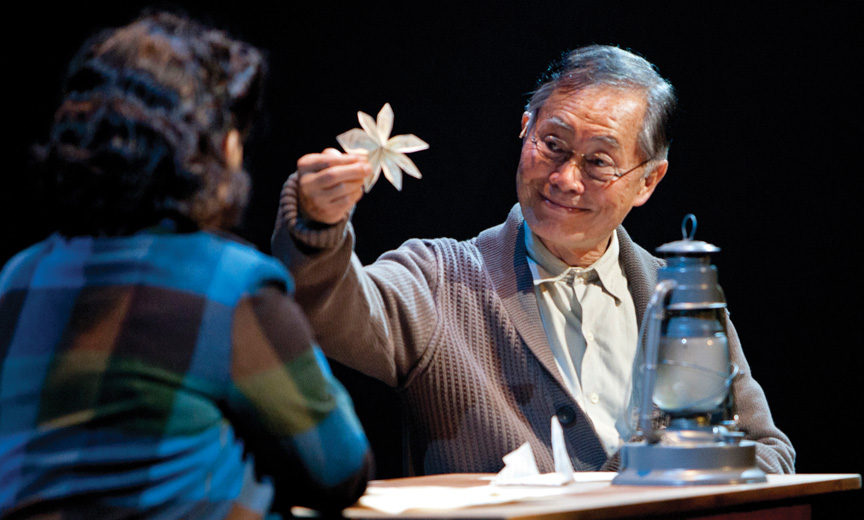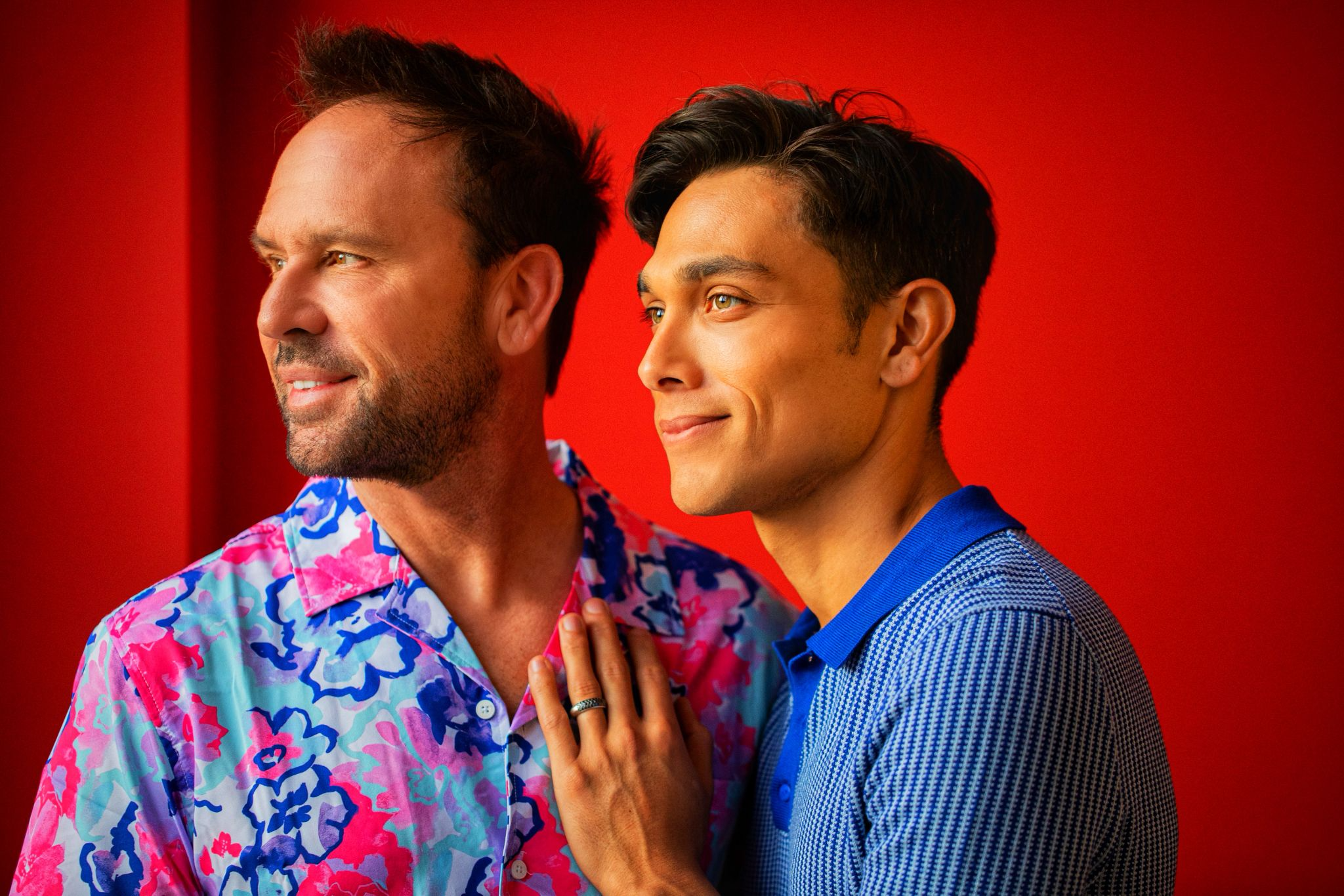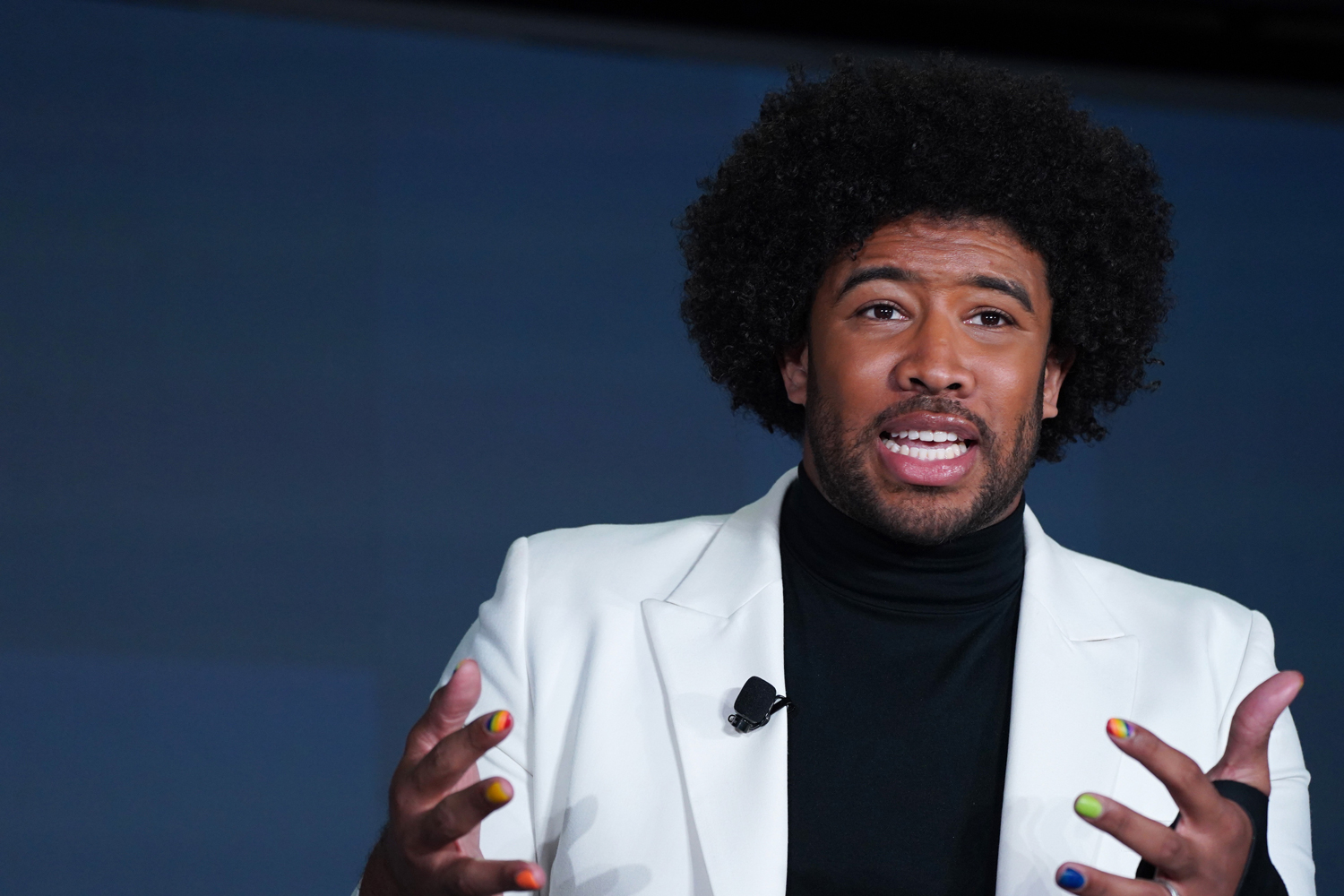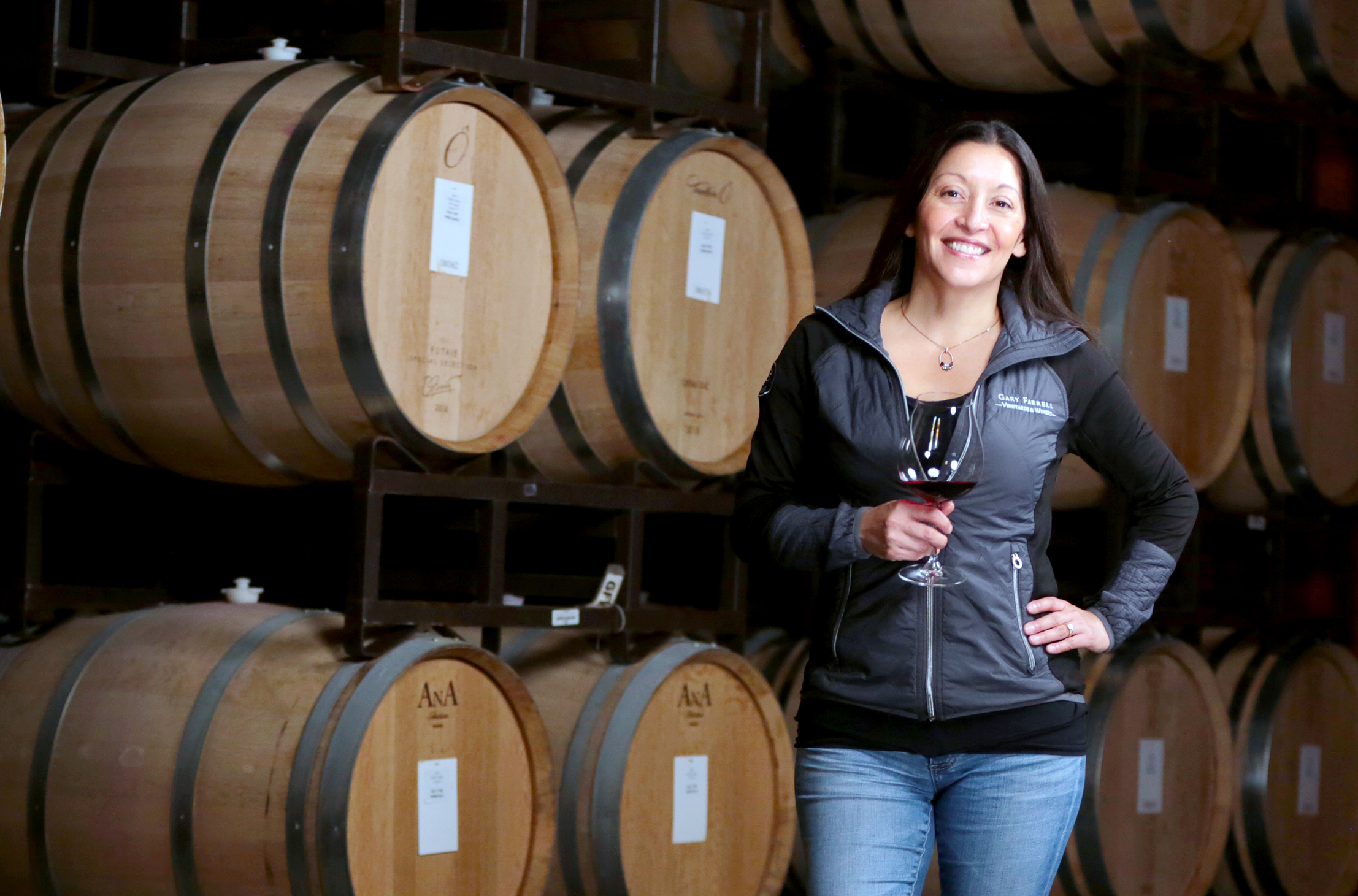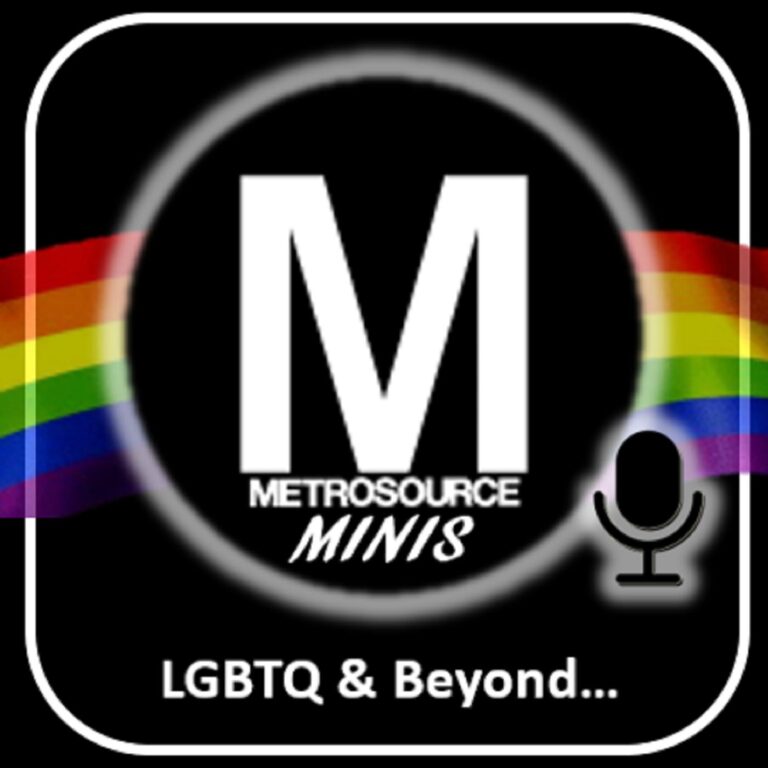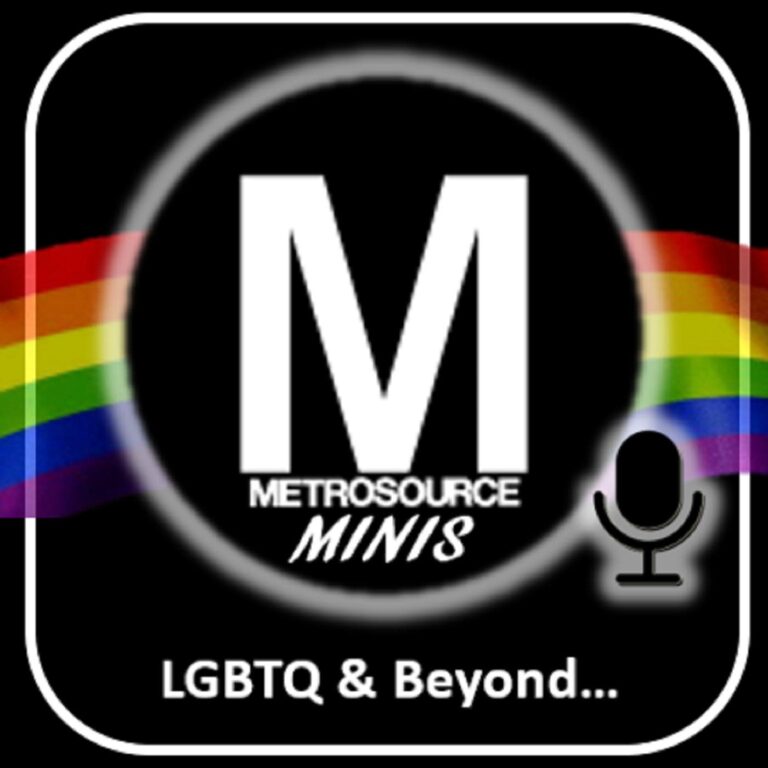Gay icon George Takei arrives on Broadway in a special show that reflects a part of his own life story and a seldom-discussed part of American history.
George Takei may be most famous for his role as Sulu in the original Star Trek franchise but in recent years, he has lit up the internet with millions who follow his wry social-media presence on Facebook and Twitter. Takei took time to talk to Metrosource, while preparing for his Broadway debut in Allegiance, about the musical’s creation, his commitment to civil rights and the art of the internet.
How did the Allegiance project get started?
It’s been my mission to talk about the [Japanese-American] internment camps ever since my late teens. To this day I come across people whom I consider to be well informed who — when I tell them about growing up behind barbed wires — they’re shocked that it actually happened in the United States.
Why do you think so many Americans don’t know?
It’s a shameful chapter of American history. I know when I became a teenager I couldn’t reconcile my childhood experience with the ideals of democracy I was reading about in my civics book. … I’ve been an activist supporting the good candidates for public offices and good issues ever since. I was involved in the Civil Rights Movement, the peace movement during the Vietnam War, and the movement to get apology from the government for the incarceration. … The fact that I’ve been able to take that life mission and merge it with my passion for musical theater on the biggest and most important stage in the United States, a Broadway stage, for the first time is groundbreaking.
Read Next | This is What Happened When Amazon Met Whole Foods
Did you know you wanted it to be a musical?
Musical theater was not what I had envisioned but [my husband Brad and I] come to New York periodically — to see plays. … One night we went to see Forbidden Broadway. We got there early and were sitting there, chatting, and two guys came in and sat in the seats in front of us. One of them recognized my voice and said, “You’re George Takei, aren’t you?” … The next night we went to see In the Heights, and we got to our seats and saw, just down the row, two arms waving at us and realized it was the same two guys. We were struck by this coincidence and waved back at them, but Brad whispered to me, “I think they’re stalking us.” [One] turned out to be Jay Kuo, the composer, lyricist and co-writer of Allegiance, and the [other] turned out to be our lead producer and co-writer. We spoke briefly about my childhood incarceration at the intermission, and then after the play we went out for drinks and had dinner the next night, which was where we decided to do a musical.
Between your web series, It Takeis Two, and your enthusiastic social-media following, it seems like you’ve really been able to harness the power of the internet. What’s your secret?
I actually had a website where I wrote a monthly blog back in the ‘90s, essentially for Star Trek fans. [With the web series and social media], we narrowed in on humor, and it got the most people. We looked at things like Grumpy Cat of all things [laughs] and started emphasizing humor, and the audience grew and grew. Since I’ve also been an activist in the LGBT community I started slipping in commentaries on the LGBT equality. There’s a great overlap with the LGBT community — their supporters — and Star Trek nerds, I’ve discovered.
This year has been so exciting for the LGBT community. What do you think is next for us in 2016?
The challenges will always exist. You know, [anti-gay-marriage country clerk] Kim Davis is a personification of the challenges we face. It’s a civil rights issue, really. The Voting Rights Act was signed by President Johnson 50 years ago, and we still have the challenges of equal access to the vote. It’s the same thing with equality for LGBT people: We still don’t have a total non-discrimination act, it’s been languishing in Congress. It’s going to be a continuous effort. We made great advances, particularly this year, in 2015. It was a very important year for me because we got nationwide marriage equality, border to border, coast to coast, and this is the year of Allegiance, as well, so two of my personal missions were achieved — but we still have to keep up the work.
Our interview, published in our December 2015/January 2016 issue, continues here:
What was your first emotional connection to the writing team behind Allegiance?
[The musical] In the Heights is about a bright young girl and the father who loves her. There’s a song with the title “Inutil” which means “useless” in Spanish, in which the father sings about his inability to help his daughter go to college. For some odd reason this song triggered my father’s anguish in the Arkansas internment camp. Now, I’m a weeper, and cascades of tears came out during this song. When intermission came, the lights went blazing on and I found myself quickly wiping my face, and the two guys come clamoring over to chat with us again. When they saw me wiping the tears they asked ,“What was that all about?” and I told them why that song struck me so profoundly.
And that was the beginning of Allegiance’s journey from story to musical?
I never thought of it as a musical, but Jay [Kuo] is a composer/lyricist, and since we’re musical theater lovers we decided a musical approach would be fantastic. They lived in San Francisco, and we live in Los Angeles, but I kept up an email correspondence. At that time I happened to be the chairman of the board at the Japanese American National Museum, and so I invited them to come down and visit the museum — which tells the story of the Japanese American experience. Then they went back to San Francisco, and a week later he sent a song over, titled “Allegiance,” and there I was at my computer — weeping again. The title survived but the song did not. It’s a different song, but the title is still there.
How did you decide to actually perform in the show?
Well, I am an actor, and my passion is the theater. I make my living primarily off of television and movies, but I’ve done theater as a personal passion. I’ve never considered myself a musical theater performer. I had done musicals but it wasn’t my primary focus. I’m quite familiar with Les Miserables, Sweeney Todd and Chicago, and I understand how musical theater can be powerful in telling a dramatic story; so that’s how my participation in Allegiance as an actor came about. I did a civil rights musical called Fly Blackbird back in 1959 in Los Angeles, and that’s what initially brought me to New York in 1960 to do the off-Broadway version.
How did Lea Salonga enter the picture?
We started developing the show and needed a leading lady. The only leading lady who was also a commercial name was Lea Salonga, and we had her in mind from the very beginning. Coincidentally, she happened to be in Los Angeles on a business trip, and Jay had written a few songs already; so we had her come over to my house. Brad and I have a grand piano in our living room, and Jay played the piano and Lea sang one of the early songs that didn’t end up making it in the final version, but it was glorious to hear her voice resonate throughout the house; it was such an unbelievable experience. She was interested in Jay’s music; so we started developing the drama around her.
What was it like the first time you shared the work with an audience?
The first reading we had was in the Democracy Forum in the Japanese American National Museum. That was the big test because the audience of the reading was composed of curators, museum staff members, docents — people who lived that story. We had the reading with that forum in the 200-seat space at the museum and it was extremely well received. We got very specific pointers from the audience and found it quite helpful. After that, we came back to New York and had a staged workshop here and got more ideas and inspiration. I really feel that we learned from each workshop. I think we had two workshops in New York before taking it to San Diego’s Old Globe — where we had a record breaking sold out run, breaking their 77-year record for both box office and attendance. We thought we would just make a quick transfer to Broadway but made another discovery [laughs] you learn something every step of the way. We learned that Broadway theaters are not that easy to get. There are many producers with their products already lined up, and we had to stand in line. What we did was take advantage of that time to polish, twea, and improve the musical even more. Certain characters were dropped, and new characters were added. A production number was dropped and another created; so what we’re presenting on Broadway is a different production from the one we presented at the Old Globe.
What is your favorite song in the show?
You know there are so many songs I’ve fallen love with. … The first is called “Higher,” which Lea [Salonga] sings. It’s a biographical song for the character, expository and showing her inner fire. When she was a little girl, her mother pushed her on a swing and she wanted to go higher and higher. Her mother dies, and then she has to raise her younger brother. In the song she is pushing her brother on the swing and he wants to go higher and higher. Then she decides, despite the fact that she’s in this internment, camp: she wants to go higher. It’s a glorious song sung by Lea so beautifully, she’s luminous in it. The other song is sung between Telly [Leung] and Katie Rose Clarke. Telly’s character falls in love with the camp army nurse, a white woman — a Japanese American and a white woman in an internment camp. This is a forbidden love, during wartime, behind barbed wires. The song’s title is “With You” and it’s that story. I just love both of those songs. Another great song is a Japanese word, “Gaman,” which means to endure, or to have fortitude with dignity and pride. It’s that concept that made it possible for the Japanese Americans to survive the internment, the resilience. That word encompasses the ability to find joy under harsh circumstances, to find love: gaman.
Read Next | This Is How to Fill Your Instagram with Sexy Men
You mentioned your work with the Japanese American National Museum. Can you tell us a bit more about the organization?
We need to institutionalize our story. Together, with a group of others, we founded the museum in the mid eighties. We opened the doors to the museum for the first time in 1992, and the museum is making a real contribution to awareness and giving the opportunity for Americans to know our history fully. You can’t learn from history if you don’t know the history. For a long time there was a lack of information about this history in traditional history books. There are, of course, more resources on the subject now but the Japanese American National Museum’s existence is affiliated with the Smithsonian, and I served as the chairman from 2000 to 2004, and we’re passionate about telling the story.
You mentioned the show’s remarkably successful run at The Old Globe. How did you find audiences responded to it there?
The gratifying and amazing aspect of having the first performance of Allegiance performed at the Old Globe meant that younger Japanese Americans knew their grandparents were in the internment camps — but that’s all they knew about it. Their parents or grandparents most likely refused to talk about it. They felt too ashamed for being accused of being spies or partially-to-blame for the bombing of Pearl Harbor; so they didn’t talk about it. Because they didn’t talk about it, Japanese Americans weren’t discovering the truth of the internment — the anguish and the joy. Many people’s parents were born inside the camps and that’s because people fell in love and had children. It’s a testament to the resilience of Japanese Americans, they were able to find joy and love and create family behind those barbed wire fences. The younger Japanese Americans didn’t know that. They say to me that they learned about the story of the internment for the first time by seeing Allegiance. That was a gratifying discovery for me. We’re doing this to raise the awareness for all Americans. It’s something that informs Japanese Americans and everyone’s experience.
How did activism become such an important part of your life?
I was one of those young students who lived in the library, and I was always hunting for more information about the internment, but it wasn’t there. I engaged my father in after-dinner conversations, and some of them got pretty heated. I was an idealistic child, inspired by Dr. Martin Luther King, and our discussions got a little intense, but overall [my father] was the man who suffered the most in my life. He lost everything and explained democracy to me. He said, “Ours is a people’s democracy, and it can be as great as we want it to be, but it’s as fallible as people are. Our democracy is dependent on good people who cherish our ideals and who actively engage in the political process.”
One Sunday he took me down to the Adlai Stevenson for President headquarters and he volunteered me for the campaign and there I met other passionate people and I saw, experienced, and started to understand what makes our democracy work.
To learn more about Allegiance, visit allegiancemusical.com. For more about Takei’s other projects, head to georgetakei.com.

Read Next | Finding an Outstanding LGBT-Friendly Lawyer in New York
Last modified: September 18, 2019

